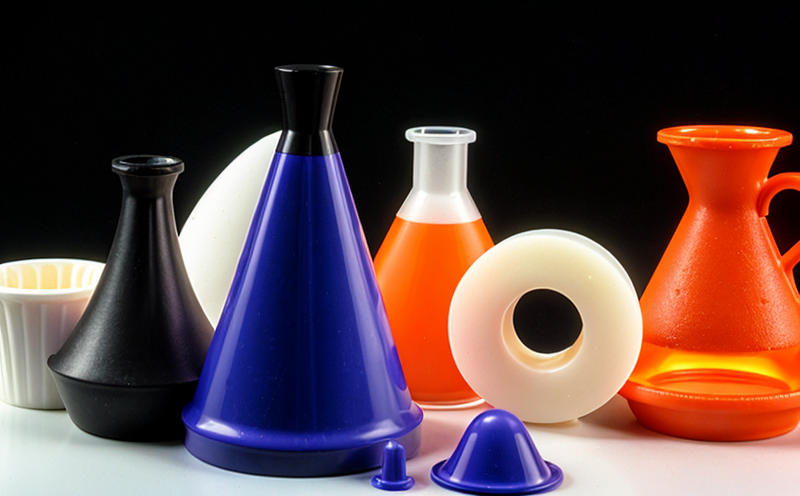GB T 9341 Flexural Testing of Plastic Materials
The Flexural Testing of Plastic Materials According to GB/T 9341 is a standard practice widely used in the chemical testing sector, particularly within polymer and additive analysis. This method assesses the flexural properties of plastic materials, which are critical for determining their mechanical strength and durability under bending stress.
The test is conducted by applying a load to a specimen until it breaks or reaches a specified deflection point. The primary focus is on understanding how these materials perform under conditions that simulate real-world applications such as automotive components, electrical insulation, and packaging materials. Compliance with this standard ensures consistent quality across manufacturing processes.
Before conducting the test, specimens must be prepared according to specified dimensions outlined in GB/T 9341. Specimens are typically rectangular or cylindrical shapes cut from larger pieces of plastic material. Proper specimen preparation is crucial as any deviation can lead to inaccurate results. After cutting, specimens need to undergo conditioning to ensure they reach equilibrium with the ambient conditions before testing.
The testing apparatus consists of a universal testing machine capable of applying controlled loads at constant rates. This equipment ensures precise measurement and control over loading conditions during tests. Specimens are mounted between two supports that allow for deflection under applied load until failure occurs or specified displacement is reached.
Accurate data collection plays a vital role in interpreting results correctly. Parameters measured include maximum load capacity, flexural modulus of elasticity (also known as Young's modulus), and fracture stress. These metrics provide valuable insights into the material’s performance characteristics.
To ensure accurate results, it is essential to follow all procedures outlined in GB/T 9341 strictly. Deviations from these guidelines may result in misleading interpretations about a polymer or additive’s actual capabilities when used in various applications.
Understanding the flexural behavior of plastic materials helps manufacturers optimize their products for better performance and durability while maintaining cost-effectiveness throughout production cycles.
In summary, GB/T 9341 provides critical information regarding the mechanical properties of plastics through controlled flexural tests. By adhering to this standard, industries can develop more reliable and robust products that meet stringent quality requirements set forth by regulatory bodies worldwide.
Scope and Methodology
The scope of GB/T 9341 covers the determination of flexural strength, modulus of rupture (also called flexural yield strength), and flexural modulus of elasticity for various types of plastic materials. This includes thermoplastics, thermosets, elastomers, composites containing plastics, and similar items.
The methodology involves preparing specimens according to specified dimensions and tolerances as detailed in the standard. Specimens are then conditioned at specific temperatures and humidity levels before being tested using a universal testing machine capable of applying controlled loads at constant rates.
- Specimen preparation
- Conditioning procedures
- Testing equipment requirements
- Data acquisition process
- Calculation methods for key parameters
The methodology emphasizes the importance of proper specimen preparation and conditioning to ensure accurate testing results. It also highlights the necessity of using appropriate testing equipment capable of applying controlled loads at constant rates.
Data from flexural tests can be used in several ways, including:
- Comparing different materials or formulations
- Monitoring changes over time due to aging or environmental factors
- Guiding process improvements aimed at enhancing product performance and reliability
By following the guidelines specified in GB/T 9341, laboratories can produce reliable and repeatable data that supports informed decision-making within their organizations.
Benefits
The primary benefit of conducting flexural tests according to GB/T 9341 lies in its ability to provide valuable insights into the mechanical properties of plastic materials. This knowledge enables manufacturers to make informed decisions regarding material selection and process optimization.
- Improved Product Quality: Understanding how plastics behave under bending stress allows for better design and development of products that meet both functional and aesthetic requirements.
- Cost Efficiency: By selecting the most suitable plastic materials based on flexural strength data, companies can reduce costs associated with suboptimal choices or redesign efforts later in the production cycle.
- Enhanced Durability: Flexural tests help identify potential weaknesses in a material's structure, allowing manufacturers to address these issues early in the development process.
- Regulatory Compliance: Adhering to GB/T 9341 ensures that products meet relevant industry standards and regulations, enhancing reputation and marketability.
In summary, implementing flexural tests according to GB/T 9341 offers numerous advantages in terms of product quality improvement, cost efficiency enhancement, increased durability, and regulatory compliance. These benefits contribute significantly towards achieving business goals related to innovation, sustainability, and customer satisfaction.
Industry Applications
The flexural testing method described by GB/T 9341 finds extensive application across multiple industries where plastic materials play a crucial role in product design. Some key sectors include:
- Automotive Industry: Vehicles often incorporate numerous plastic components such as bumpers, interior trim parts, and structural supports that must endure significant mechanical stress during use.
- Electronic Manufacturing: Insulation materials used in wiring harnesses or circuit boards need to maintain integrity while exposed to various environmental conditions throughout their lifecycle.
- Packaging Industry: Containers made from plastics require sufficient flexibility and strength to protect contents without breaking during handling or transport.
In each of these industries, the ability to accurately assess a plastic's flexural properties is paramount. Flexural tests help ensure that materials used in manufacturing processes are capable of meeting performance expectations set forth by end-users and regulatory bodies alike.
Additionally, research and development teams benefit greatly from flexural testing as they strive to innovate new formulations or improve existing ones. By leveraging the insights gained through this process, innovators can push boundaries further towards creating even more advanced materials with superior mechanical characteristics.





